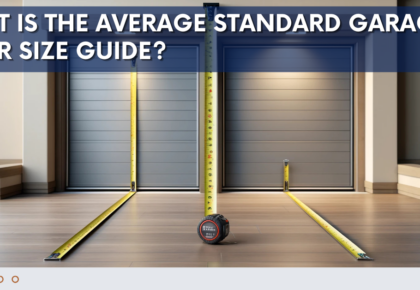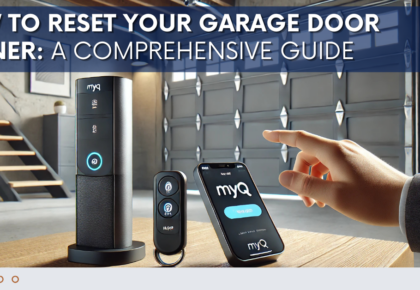When it comes to choosing a garage door, homeowners often find themselves deciding between single panel and sectional designs. Each type has its unique advantages and disadvantages, which can influence the decision based on individual needs and preferences. This article provides a comprehensive comparison to help you make an informed choice.
What is a Single Panel Garage Door?
A single panel garage door, often referred to as a one-piece or tilt-up garage door, swings open as a single, solid panel. This type of door typically uses a spring-loaded mechanism to assist with the lifting process and is known for its classic, straightforward design. Single panel garage doors are admired for their simplicity and ease of use, offering a traditional aesthetic that many homeowners appreciate.
What is a Sectional Garage Door?
A sectional garage door consists of several horizontal panels that are hinged together. These panels move up and down on a track system and are commonly used in modern residential and commercial settings due to their flexibility and space-saving design. Sectional garage doors are highly customizable, available in various materials, colors, and finishes, making them a versatile choice for contemporary homes.
Key Differences Between Single Panel and Sectional Garage Doors
Design and Construction
Single panel garage doors are made of one large, solid piece that tilts up and over the garage opening. This simple design can be more aesthetically pleasing for those seeking a classic look. In contrast, sectional garage doors are made up of multiple panels that are hinged together, allowing them to move along a set of tracks. This design offers more flexibility in terms of materials and customization options, making it suitable for a wide range of architectural styles.
Space Requirements
Single panel garage doors require more clearance space in front of the garage to swing open, which can be a limitation for some homeowners. This type of door is ideal for garages with ample driveway space. Sectional garage doors, on the other hand, require sufficient headroom and backroom for the door to operate smoothly along its tracks. They are a better choice for homes with limited front space, as the door moves vertically along the tracks without swinging outwards.
Installation Time
The installation of a sectional garage door usually takes between 4 to 6 hours for a professional installer, depending on the complexity of the system and additional features like automated openers or insulation. Single panel doors may take less time to install due to their simpler design, often being completed within a few hours. However, the installation time can vary based on the specific requirements of the door and the garage.
Weight Considerations
The weight of a garage door can vary significantly depending on the material and size. A sectional garage door generally weighs between 150 to 250 pounds, while single panel doors can be lighter or heavier based on their construction. Heavier materials like steel or wood increase the weight, requiring more robust hardware and openers. Lightweight materials like aluminum or fiberglass reduce the overall weight, making the door easier to operate and maintain.
Common Issues with Sectional Garage Doors
Sagging in the Middle
A sagging sectional garage door can be caused by wear and tear on the door’s hinges and rollers, leading to misalignment and uneven weight distribution. Another potential cause is a problem with the door’s tension springs, which may need adjustment or replacement. Regular maintenance, such as lubricating the hinges and rollers and checking the alignment, can help prevent sagging and ensure smooth operation.
Security Concerns
Sectional garage doors are generally considered secure, with robust locking mechanisms and the ability to be equipped with additional security features. These features can include smart locks, alarms, and reinforced panels. However, the complexity of their design can sometimes lead to more points of failure compared to single panel doors. Ensuring all components are in good condition and regularly maintained can enhance the security of sectional doors.
Cost Comparison: Single Panel vs. Sectional Garage Doors

Single panel garage doors are generally less expensive upfront due to their simpler design and fewer components. However, sectional garage doors can offer better insulation and security, which may provide cost savings in energy efficiency and reduced maintenance over time. The initial higher cost of sectional doors can be offset by their durability and the added value they bring to the home.
Replacing Your Garage Door
Replacing a single panel garage door involves removing the old door and installing the new one, typically within a few hours. Homeowners may choose to upgrade to a sectional door for added benefits, but single panel replacements remain a viable option for those looking to maintain a traditional look. Considerations for replacement include the condition of the existing door, the need for improved insulation, and aesthetic preferences.
Garage Door Hardware and Openers
Single panel garage doors rely on specific hardware, including robust hinges and a spring-loaded mechanism. Regular maintenance of this hardware is crucial to ensure smooth and safe operation. Sectional garage doors require a track system and multiple hinges. Both types of doors need compatible openers, with sectional doors often requiring more robust systems due to their segmented design. Modern openers offer features like remote control operation, smartphone connectivity, and automatic closing, enhancing convenience and security.
Making the Right Choice for Your Home
By understanding the differences and unique features of single panel and sectional garage doors, homeowners can make informed decisions that best suit their needs and preferences. Consider factors such as space requirements, aesthetic preferences, security needs, and budget when choosing between the two types. Both options offer distinct advantages that can enhance the functionality and appearance of any garage, making it essential to choose the one that aligns with your specific requirements.








